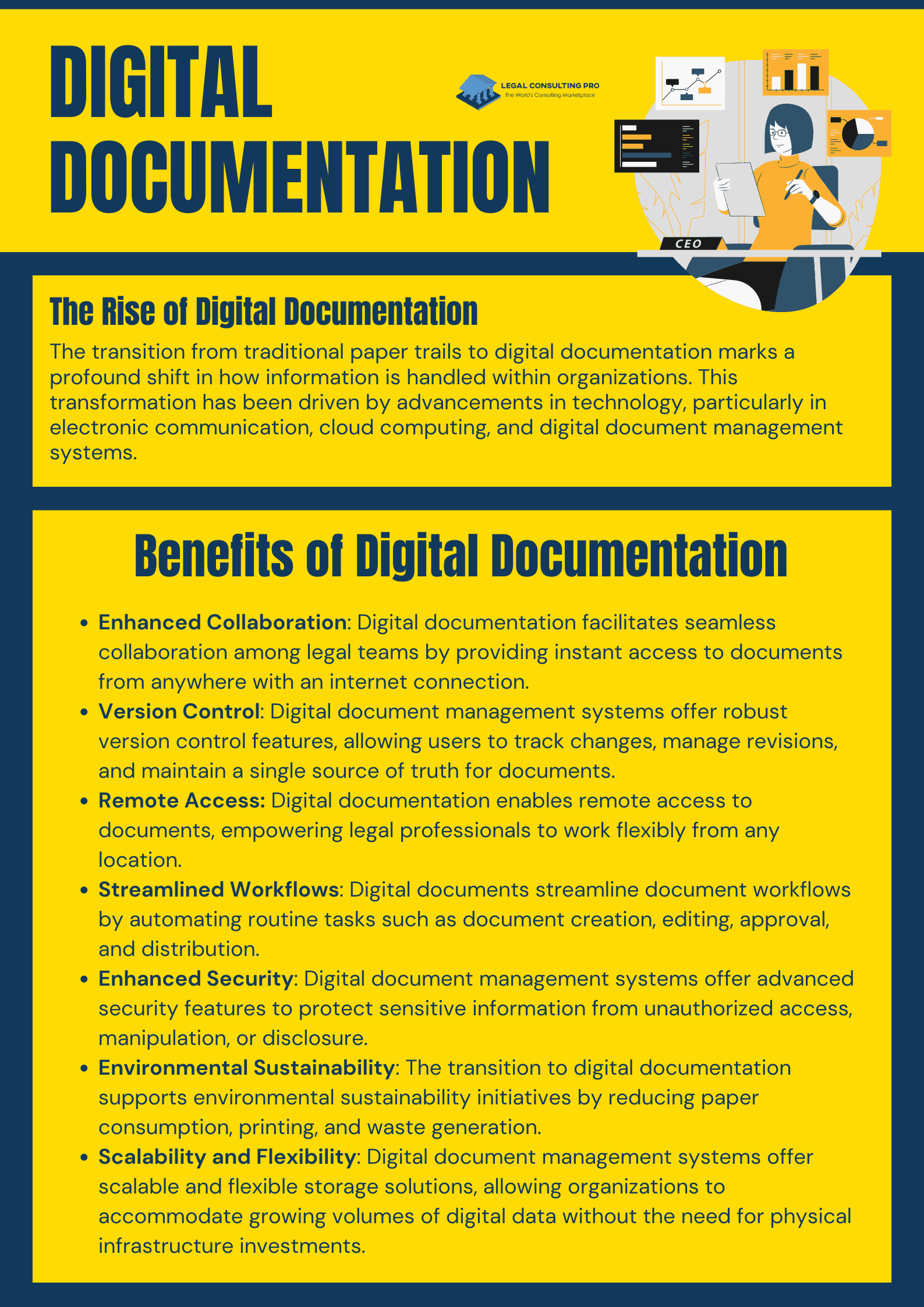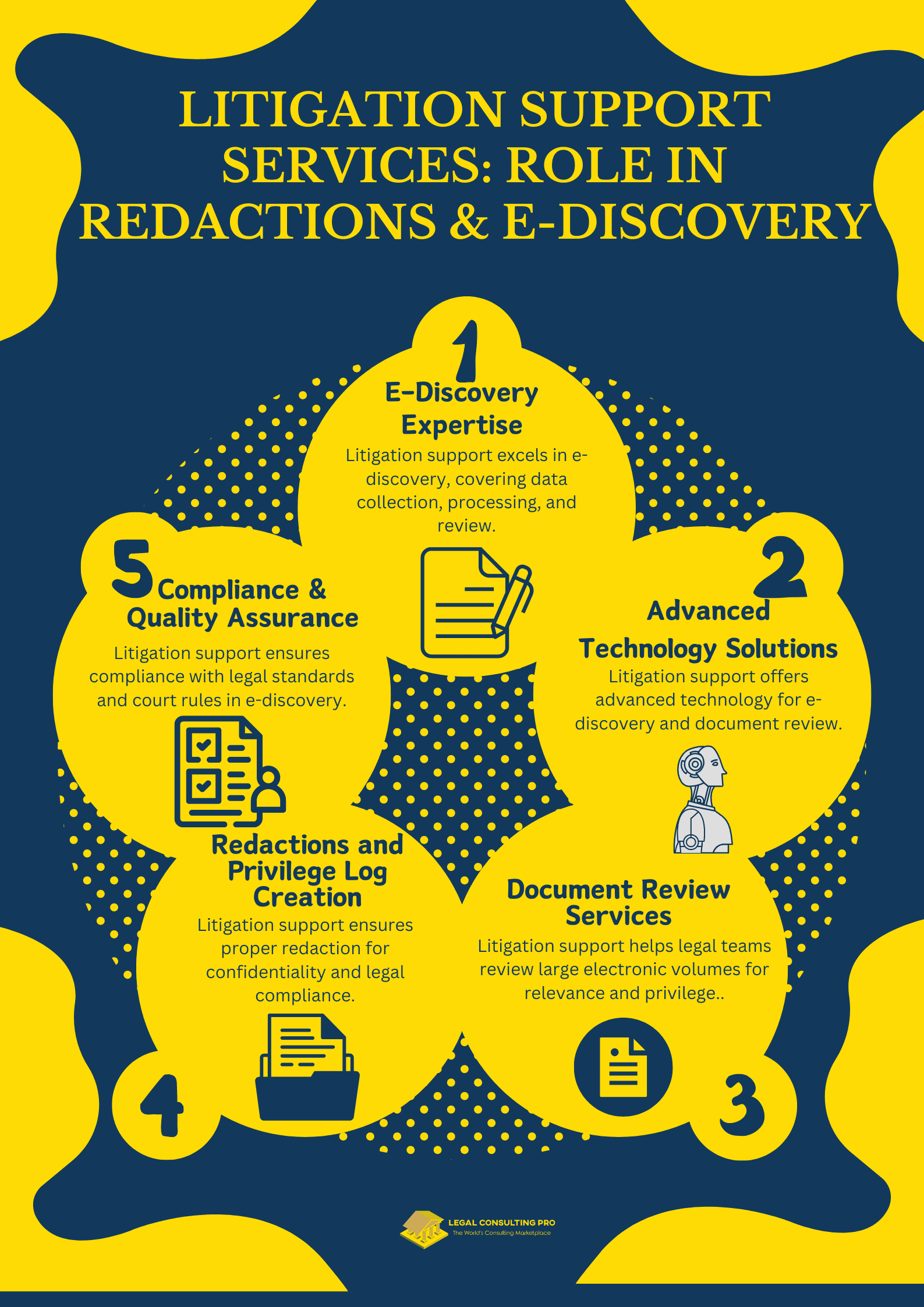In the digital age, where vast amounts of data are generated and stored electronically, the process of redactions and e-discovery has undergone a significant transformation. From traditional paper-based documentation to digital files and electronic communication, the proliferation of digital information has presented both opportunities and challenges for litigation support services professionals. This article delves into the evolution of redactions and e-discovery in the digital age, highlighting the role of litigation support services and the importance of effective strategies in navigating complex legal landscapes.
The Rise of Digital Documentation
The transition from traditional paper trails to digital documentation marks a profound shift in how information is handled within organizations. This transformation has been driven by advancements in technology, particularly in electronic communication, cloud computing, and digital document management systems. These innovations have fundamentally altered the way organizations create, share, and store information, leading to several significant changes:
- Increased Accessibility: Digital documentation allows for instant access to information from virtually anywhere with an internet connection. Unlike paper documents that may be confined to physical filing cabinets or offices, digital files can be accessed remotely, enabling seamless collaboration among team members regardless of their location. This accessibility enhances productivity and efficiency by eliminating the need for physical retrieval and sharing of documents.
- Enhanced Efficiency: The digitization of documents streamlines various business processes, making tasks such as document creation, editing, and distribution more efficient. Electronic communication platforms facilitate real-time collaboration, enabling multiple stakeholders to contribute to documents simultaneously. Additionally, digital document management systems automate routine tasks such as version control, file organization, and archival, reducing the time and effort required for administrative tasks.
- Diversification of Data Types: In addition to text-based documents, organizations now generate and manage a wide range of digital data types, including emails, memos, spreadsheets, presentations, contracts, and financial records. This diversification of data types reflects the evolving nature of business operations and communication methods. By digitizing diverse forms of information, organizations can capture a more comprehensive view of their activities and operations.
- Scalability and Flexibility: Cloud computing has revolutionized the storage and management of digital data by providing scalable and flexible storage solutions. Organizations can leverage cloud-based storage platforms to store vast volumes of data securely, without the need for physical infrastructure investments. Cloud storage also offers flexibility in accessing and managing data, allowing organizations to adapt to changing storage requirements and business needs dynamically.
- Improved Security and Compliance: Digital document management systems offer advanced security features to protect sensitive information from unauthorized access, manipulation, or disclosure. Encryption, access controls, and audit trails help safeguard digital assets against cyber threats and data breaches. Additionally, digital documentation facilitates compliance with regulatory requirements by enabling organizations to implement robust data governance and compliance measures, such as retention policies and data encryption.
Overall, the transition from paper trails to pixels represents a paradigm shift in how organizations handle information. By embracing digital documentation, organizations can leverage technology to enhance accessibility, efficiency, scalability, and security in managing their data assets. As organizations continue to adapt to the digital age, the importance of effective digital document management practices will only grow, enabling them to stay competitive and agile in an increasingly digital world.
Benefits of Digital Documentation
- Enhanced Collaboration: Digital documentation facilitates seamless collaboration among legal teams by providing instant access to documents from anywhere with an internet connection. Team members can collaborate in real time, share feedback, and make revisions without the constraints of physical proximity. This enhanced collaboration fosters teamwork, improves communication, and accelerates decision-making processes.
- Version Control: Digital document management systems offer robust version control features, allowing users to track changes, manage revisions, and maintain a single source of truth for documents. Version control eliminates the confusion and errors associated with multiple copies of paper documents, ensuring that team members always work with the most up-to-date information. This promotes consistency, accuracy, and transparency in document management processes.
- Remote Access: Digital documentation enables remote access to documents, empowering legal professionals to work flexibly from any location. Whether working from home, traveling, or attending court hearings, legal professionals can access critical documents securely through cloud-based document management platforms. Remote access enhances productivity, reduces downtime, and supports work-life balance for legal professionals.
- Streamlined Workflows: Digital documents streamline document workflows by automating routine tasks such as document creation, editing, approval, and distribution. Workflow automation improves efficiency, reduces manual errors, and accelerates document processing times. Legal teams can leverage workflow templates, approval workflows, and document routing rules to standardize processes and ensure compliance with organizational policies and procedures.
- Enhanced Security: Digital document management systems offer advanced security features to protect sensitive information from unauthorized access, manipulation, or disclosure. Encryption, access controls, and audit trails help safeguard digital assets against cyber threats and data breaches. Additionally, digital documentation facilitates compliance with regulatory requirements by enabling organizations to implement robust data governance and compliance measures, such as retention policies and data encryption.
- Environmental Sustainability: The transition to digital documentation supports environmental sustainability initiatives by reducing paper consumption, printing, and waste generation. By minimizing reliance on paper-based documentation, organizations can lower their carbon footprint, conserve natural resources, and contribute to a greener, more sustainable future. Digital documentation aligns with corporate social responsibility goals and demonstrates a commitment to environmental stewardship.
- Scalability and Flexibility: Digital document management systems offer scalable and flexible storage solutions, allowing organizations to accommodate growing volumes of digital data without the need for physical infrastructure investments. Cloud-based storage platforms provide on-demand scalability, enabling organizations to expand storage capacity as needed and adjust resource allocation based on fluctuating storage requirements. This scalability and flexibility support business growth, agility, and adaptability in dynamic environments.

Redactions in the Digital Age
Redactions, the process of obscuring or removing sensitive information from documents, have evolved significantly in the digital age due to the proliferation of electronic files and the complexities associated with managing digital data. Traditionally, redactions were performed manually using black markers on paper documents, a labor-intensive and error-prone process that lacked precision and scalability. However, advancements in technology have revolutionized the redaction process, enabling legal professionals to leverage digital redaction tools with advanced capabilities and functionalities.
Automated Redactions Tools:
- Optical Character Recognition (OCR): Digital redaction tools utilize OCR technology to scan electronic documents and identify text elements that require redactions. OCR algorithms analyze document content, recognize characters, and convert scanned images into searchable and editable text. This enables automated detection of sensitive information such as names, addresses, social security numbers, and financial data within electronic files.
- Pattern Recognition: Advanced redaction tools employ pattern recognition algorithms to identify and redact recurring elements or patterns in documents. By analyzing document structures and layouts, these algorithms can detect and redact sensitive information consistently across multiple pages or documents. Common patterns include dates, phone numbers, email addresses, and legal citations, which may require redactions to protect confidentiality and privacy.
- Machine Learning: Some digital redaction tools leverage machine learning algorithms to improve accuracy and efficiency in identifying sensitive information. Machine learning models are trained on large datasets of annotated documents to recognize patterns and contexts associated with different types of sensitive information. As a result, these tools can adapt and refine redaction techniques based on feedback from users, enhancing their effectiveness over time.
Redaction Workflows and Customization:
Digital redaction tools offer customizable workflows and options to tailor redaction processes to specific requirements and preferences. Users can define redaction parameters, specify search criteria, and set preferences for redaction styles and annotations. Additionally, redaction tools may provide options for manual review and validation of redacted content, allowing users to verify accuracy and completeness before finalizing redactions.
Batch Processing: Digital redaction tools support batch processing capabilities, enabling users to redact multiple documents simultaneously. Batch processing streamlines the redaction process and improves efficiency in handling large volumes of electronic files, such as discovery documents, contracts, and regulatory filings. Users can apply consistent redaction criteria across multiple documents, ensuring uniformity and compliance with legal requirements.
Metadata Management and Document Integrity:
Digital redaction tools address metadata risks associated with electronic documents by preserving document integrity and removing hidden information that may reveal sensitive details. Metadata, such as author names, revision history, and document properties, can inadvertently disclose confidential information if not properly redacted. Redaction tools sanitize metadata to ensure that sensitive information is not inadvertently disclosed and maintain document authenticity and integrity throughout the redaction process.
Document Conversion and Export: Redaction tools support document conversion and export functionalities to ensure compatibility and accessibility across different file formats and platforms. Users can redact documents in various formats, including PDF, Microsoft Word, Excel, and PowerPoint, and export redacted versions for distribution, sharing, or submission in legal proceedings. Document conversion preserves redactions and formatting, allowing users to maintain document consistency and compliance with legal requirements.
In summary, digital redaction tools have revolutionized the redaction process, offering advanced capabilities, automation, and customization options to meet the complex requirements of modern legal environments. By leveraging digital redaction tools, legal professionals can enhance efficiency, accuracy, and compliance in redacting sensitive information from electronic documents, ensuring confidentiality, privacy, and legal compliance in an increasingly digital world.
Litigation Support Services: Role in Redactions & E-Discovery
In today’s digital age, litigation support services have become indispensable allies for litigation support services teams navigating the complexities of e-discovery, document review, and redaction processes. These specialized services offer a wide range of expertise, cutting-edge technology, and invaluable resources to help litigation support services professionals effectively manage electronic evidence and streamline litigation processes.
E-Discovery Expertise:
- Litigation support services bring extensive experience and expertise in e-discovery processes, including data collection, preservation, processing, review, and production. They understand the intricacies of electronic evidence and the legal requirements governing its collection and presentation in litigation.
- E-discovery experts assist litigation support services teams in developing comprehensive strategies for identifying, collecting, and analyzing electronic evidence relevant to legal proceedings. They advise on best practices, technology solutions, and legal compliance requirements to ensure that electronic evidence is obtained and preserved in accordance with legal standards and protocols.
Advanced Technology Solutions:
- Litigation support services providers offer state-of-the-art technology solutions for e-discovery, document review, and case management. These include e-discovery software platforms, document review tools, data analytics software, and predictive coding technologies.
- By leveraging advanced technology solutions, litigation support services teams can efficiently process, review, and analyze large volumes of electronic evidence, saving time and resources in litigation preparation. These tools facilitate keyword searches, concept clustering, document categorization, and metadata analysis, enabling legal professionals to uncover relevant information and insights efficiently.
Document Review Services:
- Litigation support services assist legal teams in conducting document review projects, which often involve the analysis of vast volumes of electronic documents for relevance, privilege, and responsiveness. Reviewers meticulously examine electronic documents, identify privileged or sensitive information, and apply appropriate redactions to protect confidentiality.
- Experienced reviewers and analysts employed by litigation support services providers ensure consistency, accuracy, and quality in document review processes. They adhere to predefined review protocols, coding guidelines, and quality control measures to meet the rigorous standards of legal proceedings.
Redactions and Privilege Log Creation:
- Litigation support services offer specialized expertise in redaction processes, ensuring that sensitive information is properly obscured or removed from electronic documents to protect confidentiality and comply with legal requirements. Redaction experts utilize advanced redaction tools and techniques to identify and redact sensitive information consistently and accurately.
- Additionally, litigation support services providers assist legal teams in creating privilege logs, which document privileged communications and materials withheld from production during discovery. Privilege logs serve as crucial evidentiary records and provide transparency regarding the assertion of privilege in litigation.
Compliance and Quality Assurance:
- Litigation support services play a vital role in ensuring compliance with legal standards, court rules, and discovery obligations throughout the e-discovery process. They assist legal teams in implementing defensible strategies and workflows to minimize the risk of sanctions, adverse rulings, or spoliation claims.
- Quality assurance processes conducted by litigation support services providers help validate the accuracy, completeness, and integrity of electronic evidence and redacted documents. Through thorough quality control measures and peer review, they ensure that electronic evidence meets the highest standards of reliability and admissibility in legal proceedings.

Conclusion
In the digital age, redactions and e-discovery have become indispensable components of modern legal practice. From digital documents to electronic evidence, the management and protection of electronic information require specialized expertise, technology, and resources. Litigation support services play a crucial role in assisting legal teams with e-discovery, document review, and redaction processes, ensuring compliance with litigation support services standards, and achieving successful outcomes in litigation and regulatory matters. As digital documentation continues to proliferate, the importance of effective strategies for redactions and e-discovery in the digital age cannot be overstated.
Similar blogs:
Bunch of Benefits – How Litigation Support Services help you?
Redactions Revolution: Automation, Tools, and Tech Savvy Solutions for Efficient Reviews













































